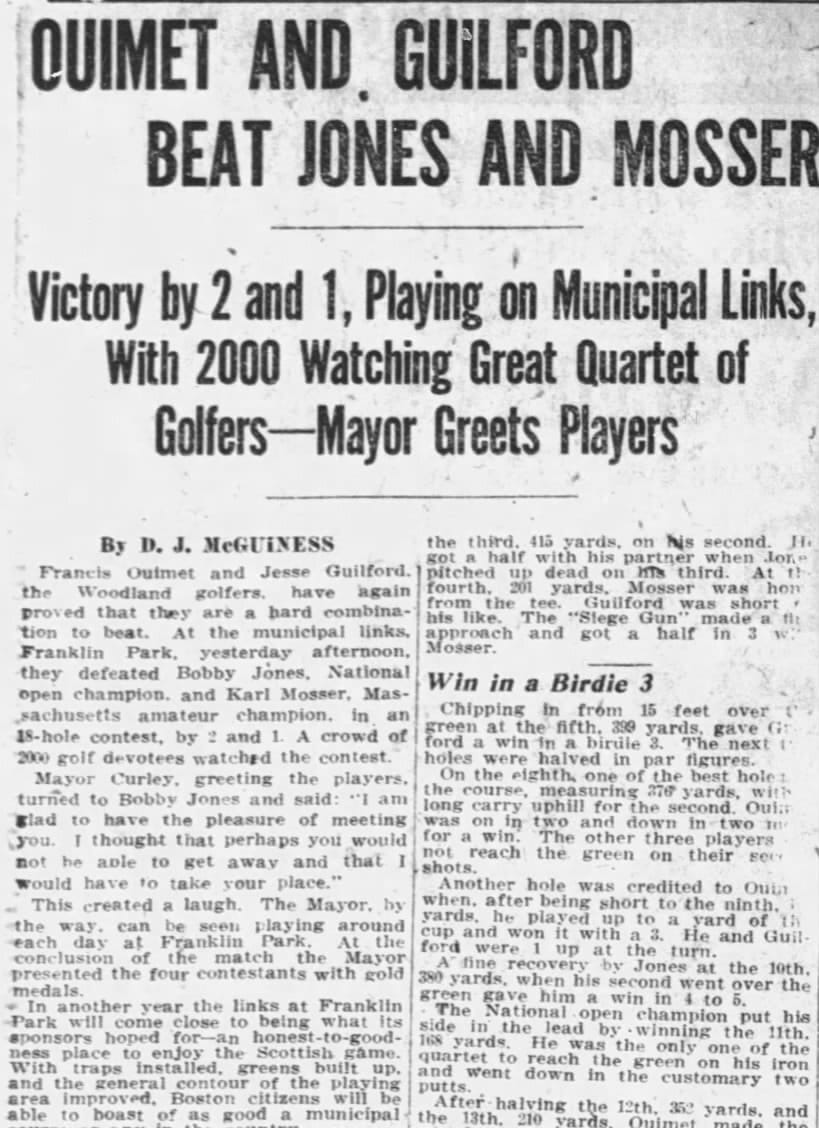- Bay State Golf
- Posts
- Bobby Jones, Franklin Park, and Augusta National
Bobby Jones, Franklin Park, and Augusta National

Bobby Jones, Franklin Park, and Augusta National
The Masters is tantalizingly close.
One of the founders of Augusta National has ties to the Boston area. The legend Bobby Jones earned his B.A. in English from Harvard in 1924. Before he graduated, he won the 1923 U.S. Open, and then he won 12 more majors from 1924 to 1930 while earning a law degree from Emory. In 1930, after winning that period’s version of the Grand Slam - U.S. Open, U.S. Amateur, Open Championship, and Amateur Championship - he walked away from competitive golf.
“It [championship golf] is something like a cage. First, you are expected to get into it, and then you are expected to stay there. But of course, nobody can stay there,” Jones said.
13 major championships as a 30-year-old is stunning stuff, but he wasn’t done with golf. He and Alister MacKenzie designed Augusta National. It opened in 1933, and it hosted the first Masters in 1934.
Augusta National is one of the most recognizable courses in the world, not just by name. Golfers from around the world could describe the holes and understand the nuances of the course after decades of watching The Masters every April on their televisions.
While Jones attended Harvard, he still needed to keep his game sharp, and Franklin Park in Dorchester was his course of choice. Well, maybe it wasn’t the course of his choosing, but there was a particular hole tucked in the back of the property that he particularly liked.
The 12th hole, a tree-lined uphill behemoth, was one of Jones’ favorite holes he’d played.

The 12th hole at Franklin Park
So he’d play the hole over and over again, trying to thread a long drive between the trees to leave a manageable approach to the green nestled at the top of the hill with a disastrous fall off to the right that would lead to certain bogey or worse.
I have played this hole a few times with my friend Kevin who has used hickories to try and conquer Franklin Park. Hickories are never easy to hit, but holes with slopes and slots that can feed the ball forward certainly make it easier to catch a few extra yards.
The 12th at Franklin Park offers no respite; the hole climbs all the way up to the green, curving slowly from right to left as the fairway tilts in the opposite direction. There are no easy yards here, and the only slopes are ones that will reject the ball and send it off to the edges of the woods.
Some have named the 12th the “Bobby Jones” hole; some reject the myth or just don’t care about it.

However, it’s hard to ignore some of the similarities that the 12th hole has with holes down at that course in Georgia Jones helped build. The elevation changes at Augusta National are always a talking point for those who are lucky enough to step foot on the property. It’s a stunning place with huge hills and steep slopes.
I’ve only been to Augusta National once, but some people who have been a lot see the 12th as the little brother of the par-5 8th. A rolling uphill hole that bends with trees protecting the playing corridors.
Like what your’re reading? Subscribe for free Friday newsletters or upgrade to Premium for extra posts like this one.
Even if you don’t want to make a hole-to-hole comparison, the hole elicits general comparisons as you stand on the tee box and look out at the fairway and wonder where the green is.
There were times when Jones would play all of Franklin Park’s holes. In 1923, after Jones had won the U.S. Open that summer, he teamed up with Karl Mosser, the Mass. Amateur champion, to play Francis Ouimet and Jesse Guilford at Franklin Park.

2000 people showed up to watch the foursome battle it out on the “Municipal Links” that October. Bobby Jones was a senior at Harvard. Ouimet and Guilford were friends from Woodland Golf Club and beat Jones and Moser 2 & 1. Ouimet was ten years removed from his own U.S. Open championship down the road at The Country Club.
Just incredible stuff.
Add in the fact that Donald Ross had just expanded the course from nine holes to 18 in 1922 after the first nine holes were built by Willie Campbell, the head pro at The Country Club, makes the 1923 match even more incredible.
So the next time you play Franklin Park, consider the 12th hole as a touch of inspiration for Augusta National, and also remember that some of the greatest golfers ever visited the course to duel on a course that was hoped to become “an honest to goodness place to enjoy the Scottish game.”
101 years later, it seems that Franklin Park has fulfilled its mission.

Reply